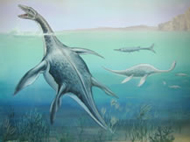 Across the world, precious opal occurs in very few locations because its formation requires very special circumstances involving the coincidence of geological and possibly biological phenomena.
Across the world, precious opal occurs in very few locations because its formation requires very special circumstances involving the coincidence of geological and possibly biological phenomena.
Scientific research and studies over the last two centuries have provided comprehensive detail about the formation of most gemstones. Unfortunately, the genesis of opal is still not properly understood. The main three formation theories may all be correct and may have applied to different locations and at different time periods. Some or all of the theories may have co-incided.
The results of thorough research will enable better targeted prospecting which could have a marked impact on the future supplies of opal and the livelihoods of thousands at the opal fields.
The Deep Weathering Model
This theory has been the oldest and most widely accepted explanation since the 1960s. During tile mid-tertiary period, around 30 million years ago, deep weathering caused chemical changes to the sediments releasing large quantities of soluble silica, which percolated downwards and along faults to an impermeable level. Here it precipitated within voids and cracks as common opal and, on rare occasions, it formed colourful precious opal.
Syntectonic Model
Some scientists believe that opal formed via the silica-laden fluids moving through the layers of sub-surface strata under fault-generated hydraulic pressure and at temperatures greater than 100°C. The faults, caused by tectonic processes, create pathways for fluids super saturated by amorphous silica. This fluid, while under pressure, becomes entrapped. It cools, gels and hardens to form opal.
Microbe Model
With the new millennium came a new theory from German scientist Dr. Hans-Jurgen Behr, who found evidence of rich aerobic soil bacteria and microbes conserved in opal. The bacteria would act as a “bio-reactor” resulting in the creation of enzymes and acids important in the formation of opal.
There is now evidence to suggest that opalisation in Australia's sedimentary deposits occurred at the same time as the sediments themselves were laid down. The presence of aerobic (oxygen-requiring) microbial remains within the opal and the discovery of opalisation of soft tissue lend weight to the theory that the opalisation process occurred quickly during the Early Cretaceous period, ever 100 million years ago.
This incredible stone continues to mystify the scientific world and is becoming increasingly elusive to miners and prospectors.
The main three formation theories may all be correct and may have applied to different locations and at different time periods. Some or all of the theories may have co-incited.





